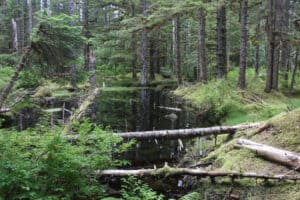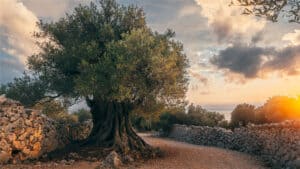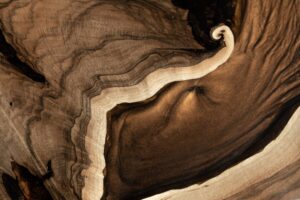Rare blue flowering trees are a standout garden feature plant, and because pollinators better see blue tones, they bring all the bees to your yard, too. However, finding a blue flowering tree isn’t simple. Few exist because plants don’t make the blue pigment. Plants create blue tones by mixing other colors, so most “blue” flowers are more purple than blue. That said, there are some gorgeous blue flowering trees out there. Here are eleven of the most irresistible!
1. Ceanothus
Evergreen ceanothus is better known as the California lilac. It blooms a heady abundance of small, frilly blue flowers along its branches from spring to summer. Flowers pack the branches so profusely that, sometimes, all you can see are happily buzzing bees.
Helping its blue flowers stand out are the small dark green leaves thickly spaced along Ceanothus’ arching branching. Its foliage is deer and rabbit-resistant.
Ceanothus is naturally a shrub, so it requires some coaxing and pruning to become a magnificent tree. First, make sure you don’t purchase a repens species, a prostrate ground-hugging form. Then, stake your Californian lilac and remove its lower branches each year until it resembles a four to six-foot-tall tree.
Ceanothus is drought tolerant once established and a great choice for coastal gardens. It suits USDA hardiness zones 7 to 10 and loves full sun in most well-drained soil types.
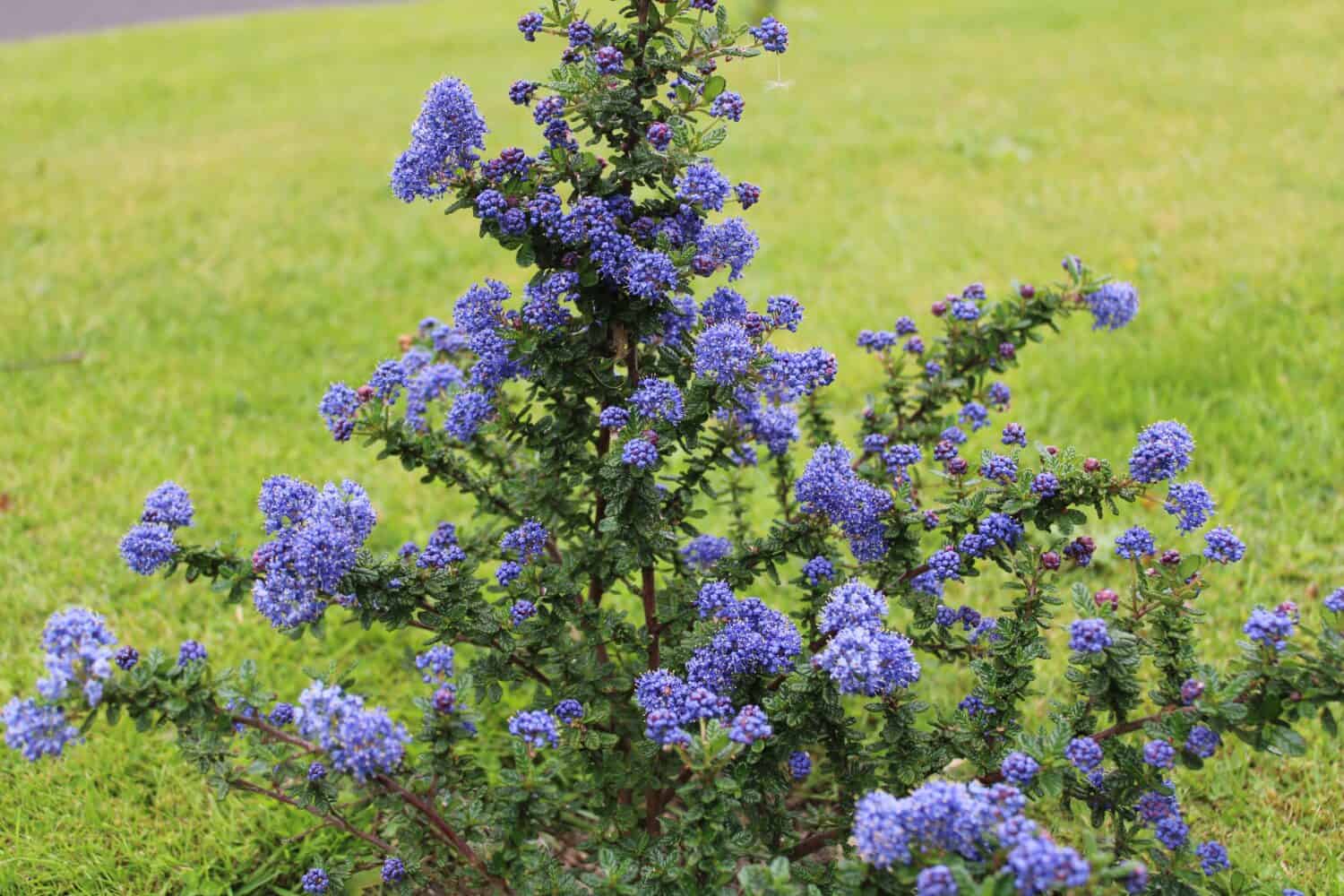
It’s easy to prune blue flowering Californian lilac into tree form.
©Susan Edmondson/Shutterstock.com
2. Orchid Tree
Exotic and showy winter-blooming orchid trees are not actually orchids; their blooms resemble an orchid’s intricate patterns. The cultivar Blue Hong Kong produces six-inch wide pale lilac-blue flowers with delicious scent.
Despite their delicate looks, Blue Hong Kong tree flowers last for months before maturing into interesting pea pod-type seeds. Flowers appear in fall and last until early spring.
This gorgeous blue flowering tree’s wide leafy green canopy creates a lightly scented shady spot in your garden and attracts hummingbirds in droves.
The Orchid tree Hong Kong Blue reaches 20 feet tall and 25 feet in spread. It suits USDA hardiness zones 9-11, so it’s very far from cold tolerant. Plant it in a sunny spot in well-drained soil and water it well until it’s established.
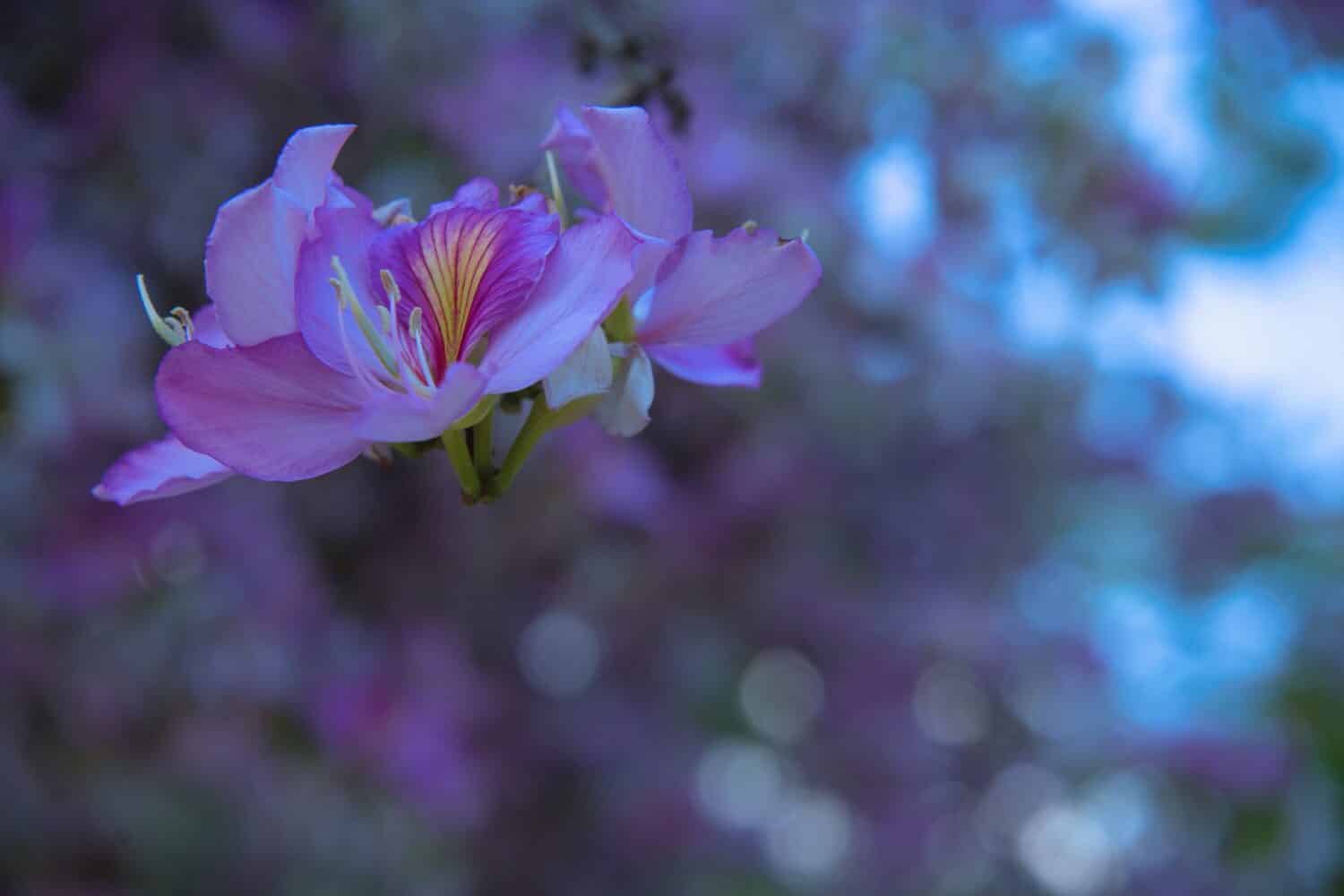
Blue orchid trees are actually related to the pea family.
©Ruth Laguna/Shutterstock.com
3. Jacaranda
Who doesn’t love a fragrant, glorious blue flowering jacaranda tree? Often called the green ebony tree, this is a beauty from the South American tropics.
It blooms incredible eight-inch-long funnel-shaped flowers in late spring to early summer in such abundance its crown turns shimmering blue. Beneath the blooms, textured, finely frilled green leaves emerge.
This is probably the best-known blue flowering tree, and for good reason! It’s absolutely gorgeous and pretty easy to grow in hot USDA zones 10-11.
Jacaranda can reach 50 feet tall and 30 feet wide, so it needs space to shine. Plant yours in full sun in well-drained but moist soil. It doesn’t mind whether you’ve acidic, neutral, or alkaline ground so long as it fully drains. Prune jacaranda in winter because the best flowers grow on fresh springtime branches.
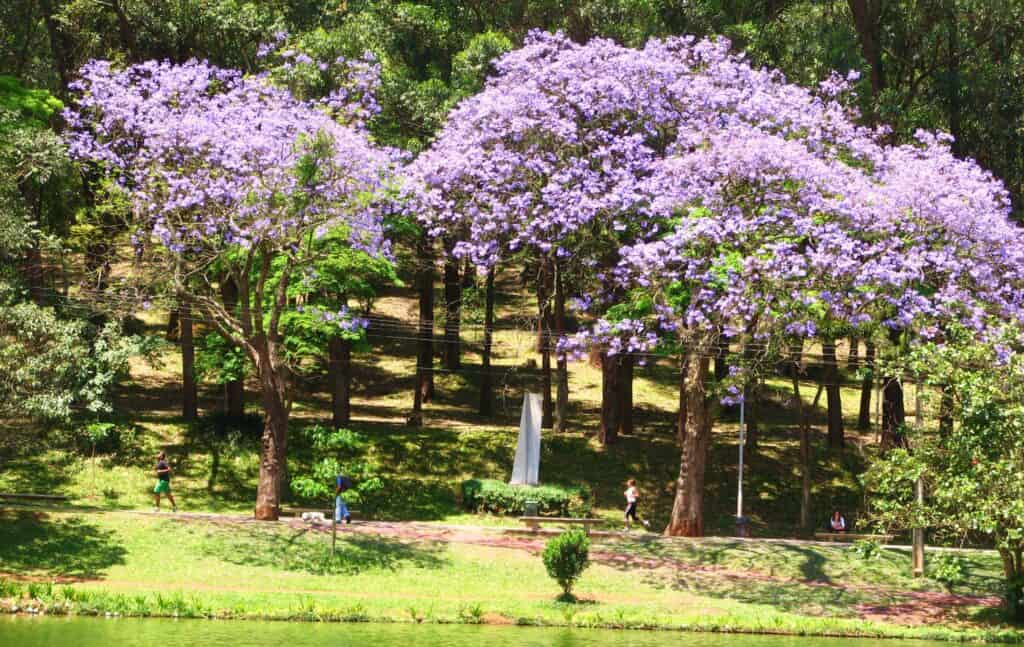
Blue flowering jacaranda trees suit USDA growing zones 10-11.
©mauro halpern / Flickr – License
4. Ironwood
Southeast Asia’s native ironwood tree, Memecylon umbellatum, is a medium-sized tree with fluffy dark blue umbel flowers in early spring to late summer. This blue, evergreen beauty has equally gorgeous glossy dark green foliage that sets off those unusual umbel blue flowers. To top off its blue credentials, Asian ironwood’s fruit also appears deep blue.
If you’re wondering, umbels are an inflorescence of numerous center-held stalks combined to make a sphere like alliums.
This tropical, salt-resistant plant grows in warm USDA hardiness zones. It needs full shade and fertile soil, so lots of rich organic mulch is required for this beauty to reach its full height of 33 feet by 15 in the spread.
Blue-flowering Asian ironwood is tricky to find. It’s pretty rare in the United States.
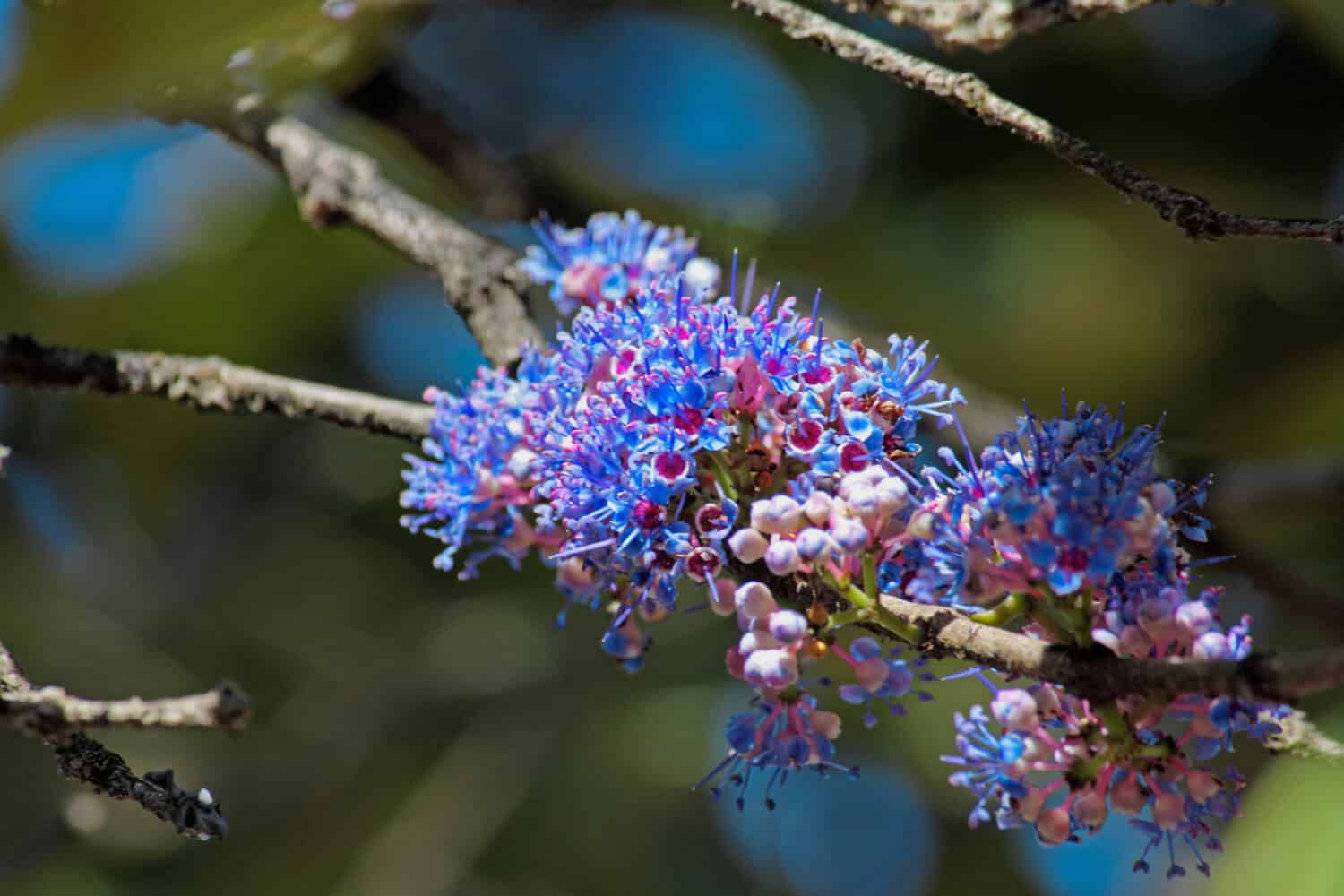
Ironwood’s umbel flowers and seeds are salt tolerant.
©yogesh_more/Shutterstock.com
5. Blue Rose of Sharon
Rose of Sharon, mallow, or hardy hibiscus syriacus, whatever you call this handsome but hardy deciduous tree, be sure to purchase a blue variety such as Blue Satin or Blue Chiffon for blue flowers. Pink and multi-hued versions are more common in garden centers.
Hibiscus syriacus trees have pale brown bark, light green lobed leaves, and large four-inch wide trumpet-shaped blue flowers with dark purple veins. They bloom in early summer to the frosts, which is great news for hungry fall-time pollinators.
Rose of Sharon is a shrub that’s easily trained into tree form. Simply pick out an upright stem, cut away the rest, and remove lower growth. Each year, cut away lower lateral growth. In around four to five years, you’ll have a six to nine-foot-tall tree-shaped Rose of Sharon with a 2-3 inch truck and a blue flowering rounded crown.
The blue rose of Sharon grows in USDA hardiness zones 5 to 9 in full sun or partial shade. Remarkably tolerant trees, they cope with poor soil and drought but need lots of water to get established.
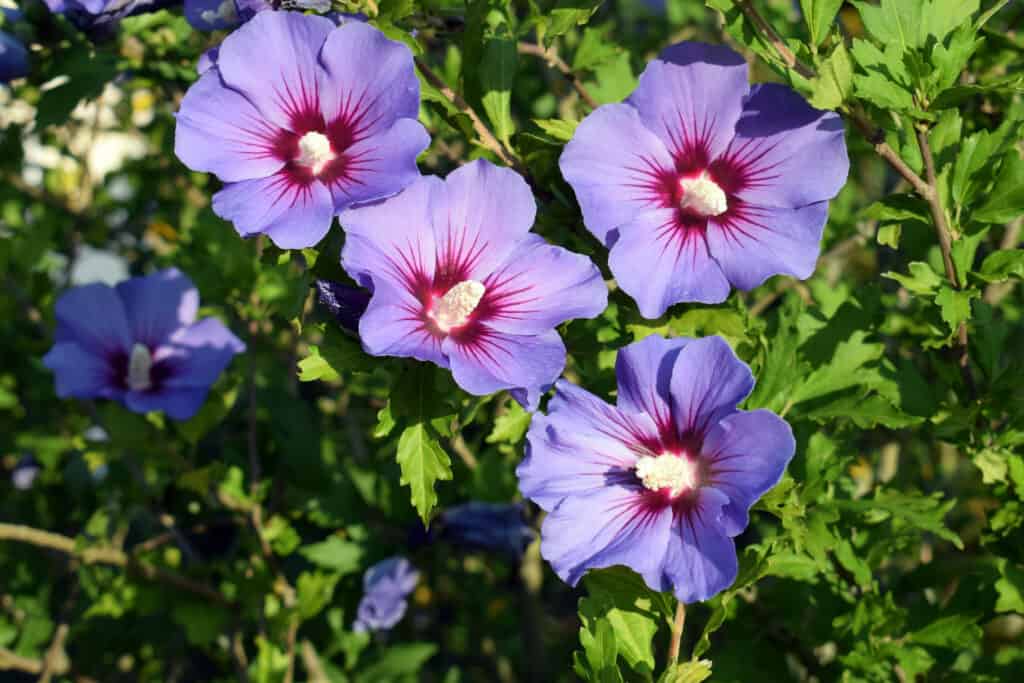
Rose of Sharon cultivars include pink and blue blooms.
©iStock.com/matunka
6. Paulownia
Paulownia is the Empress or princess tree and the fastest-growing tree in the world. It can be put on seven feet annually to a maximum of 30-40 feet tall with a spread of 20-30 feet. They, therefore, need plenty of room to grow! It’s native to Asia but thrives in USDA growing zones 5-8 in full sun with rich, fertile soil that’s well drained.
This speedy grower’s blue cultivar has spring-blooming lilac-blue flowers that resemble foxglove blooms. Its broad crown spouts 12-inch-long deep green leaves, and its blue flowers mature to green pointed pods the following year.
It’s a jewel of a tree and a rare blue flowering tree for extra-large gardens!
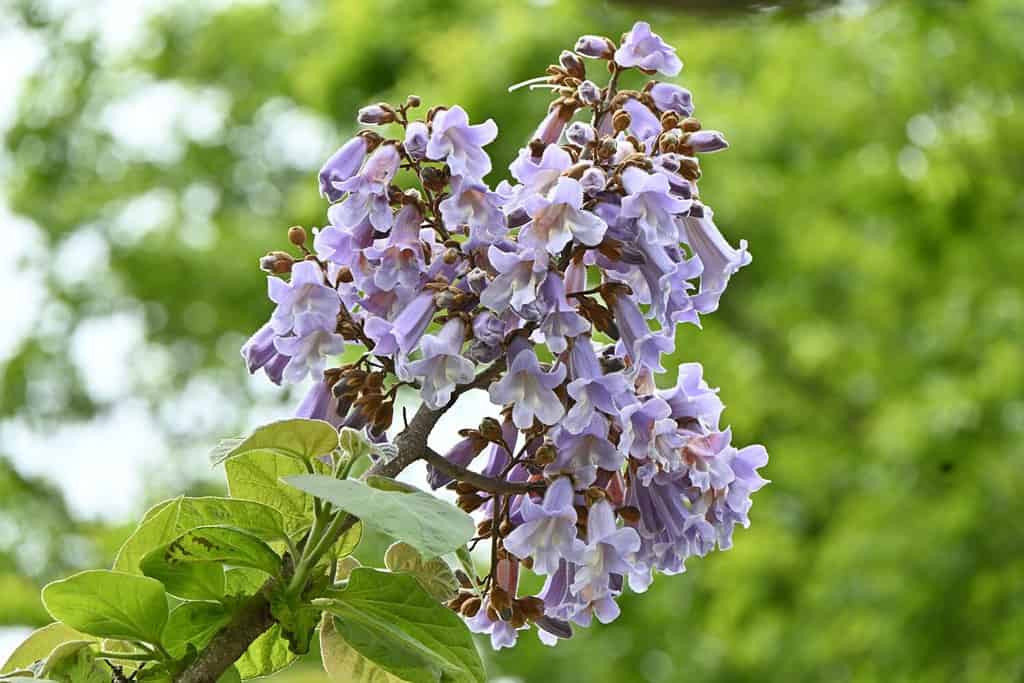
Paulownia trees can grow seven feet in one year.
©tamu1500/Shutterstock.com
7. Texas Mountain Laurel
U.S. native Texas mountain laurel is an evergreen shrub that’s slow-growing and easy-natured. Pollinators adore its purple-blue clusters of pendulous flowers that look much like wisteria without the hassle. What’s more, blue flowering Texas laurel has a deliciously sweet scent.
Its dense, leathery foliage is a garden staple all year round, and in fall, its blue flowers mature to attractive light brown pods.
Turn this blue flowering shrub into a tree by selecting an upright stem or twp and removing all its other branches. Hard prune branches emerge on the lower trunks to create a trunked tree form.
Texas laurels need full sun or partial shade to reach 25 feet tall by 10 feet in width. It’s not fussy and happy with medium fertile but well-drained soil. It’s drought-hardy once established, and although pollinators love it, rabbits and deer don’t.
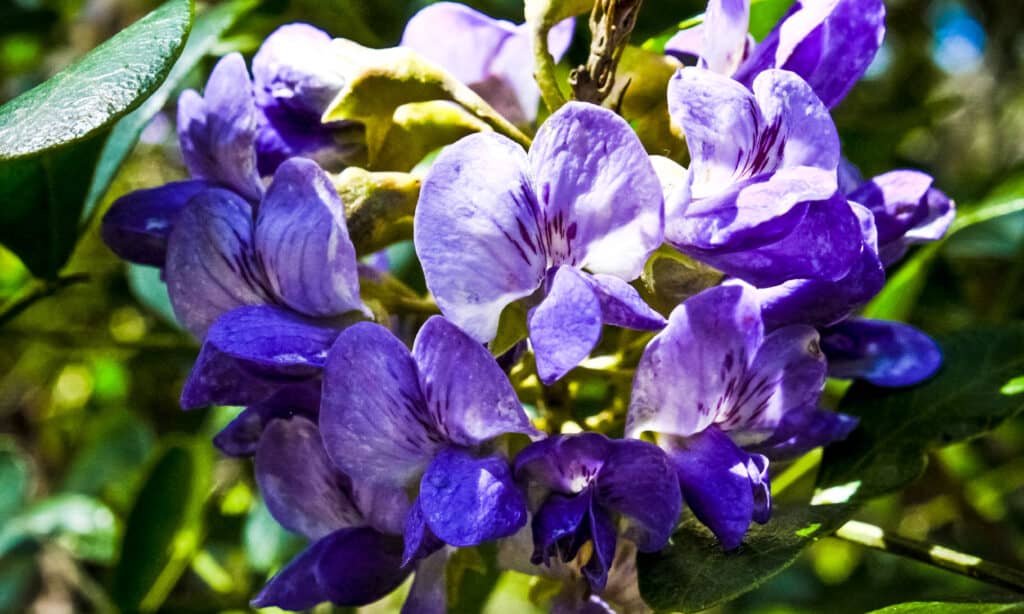
Texas mountain laurel is a blue flowering no-fuss tree.
©Dark Obsession Photography/Shutterstock.com
8. Wisteria
Instantly recognizable wisteria is a spring-blooming oriental tree with gorgeous blue flowers and an intoxicating scent.
It’s naturally a climbing shrub, but it’s easy to train against a wall or fence line because its trunk grows and then hardens each year. Beautiful drooping blue flowers and arching branches emerging from a thick wisteria trunk is a hard look to beat, so it’s worth twisting two or three stems to form a trunk.
For the first few years, strong supports are necessary, but they can be removed once enough “trunk” wood is hardened into place. Each year, trim the arching branches back to around eight feet in spread so they fall like an umbrella.
Blue flowering wisteria grows in USDA hardiness zones 5-9. It prefers full sun or partial shade with well-drained fertile soil.
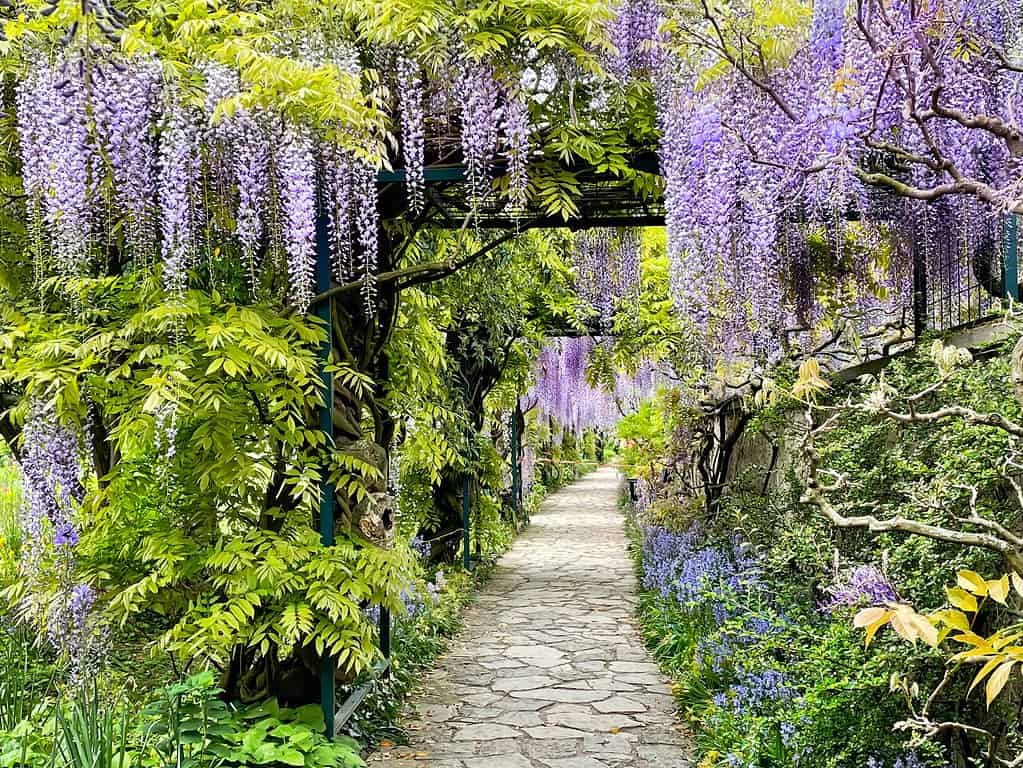
Blue wisteria takes several years to train into tree form, but the result is breathtaking.
©romrodinka/ via Getty Images
9. Blue Buddleia
From tricky wisteria to bombproof buddleia! The blue flowering butterfly bush cultivars made gorgeous hardy trees, and of course, they attract pollinators from miles around.
Blue buddleia cultivars include Buddleia Empire Blue, Nanho Blue, and Adonis Blue, which reach ten feet tall. Avoid patio varieties such as Buzz Indigo that only reach two to three feet tall unless you’re looking for dwarf blue flowering trees.
In warm growing zones, buddleia is evergreen, but in zone 5, its narrow, silvery green foliage is deciduous. Choose a sunny, well-drained border, and chances are your buddleia will thrive with very little attention. It’s one of the most low-maintenance, easy-to-grow blue flowering trees out there.
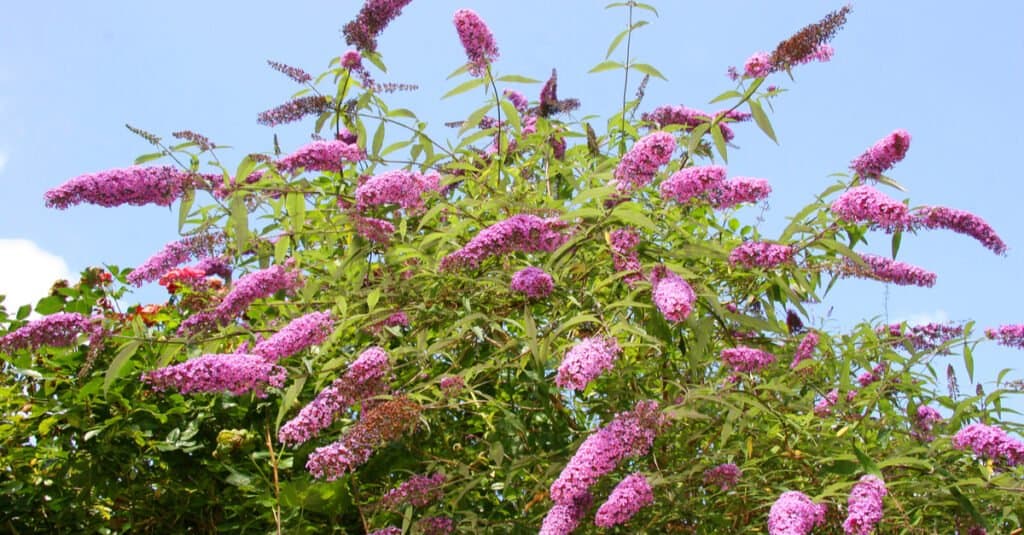
Choose Empire Blue buddleia to attract bees and butterflies to your garden.
©Dirk M. de Boer/Shutterstock.com
10. Blue Rhododendron
Blue rhododendrons have cultivars that survive zone 3, so this is a great choice for blue flowering trees in colder USD zones.
Their trumpet-shaped flower clusters emerge in early spring or summer on peeling bark, thick leathery-leafed shrubs. Depending on the cultivar, Rhodies reach six to ten feet and live for decades.
Popular rhododendrons enjoy woodland settings. Dappled shade and protection from the hot sun are important. In the wild, these hardy trees live beneath larger tree lines and put out shallow roots, so when you plant it up, keep the main root ball a few inches above ground.
Rich, acidic soil suits blue rhododendron trees best, so add lots of pine or bracken mulch to the base.
So that’s 10 of the most gorgeous blue flowering trees. Hot zone gardeners have the most choices, from wisteria to Asian ironwood and jacaranda. However, in cooler climates, blue ceanothus, buddleia, rhododendrons, and Texas mountain laurels fill gardens with cool, true blue shades.
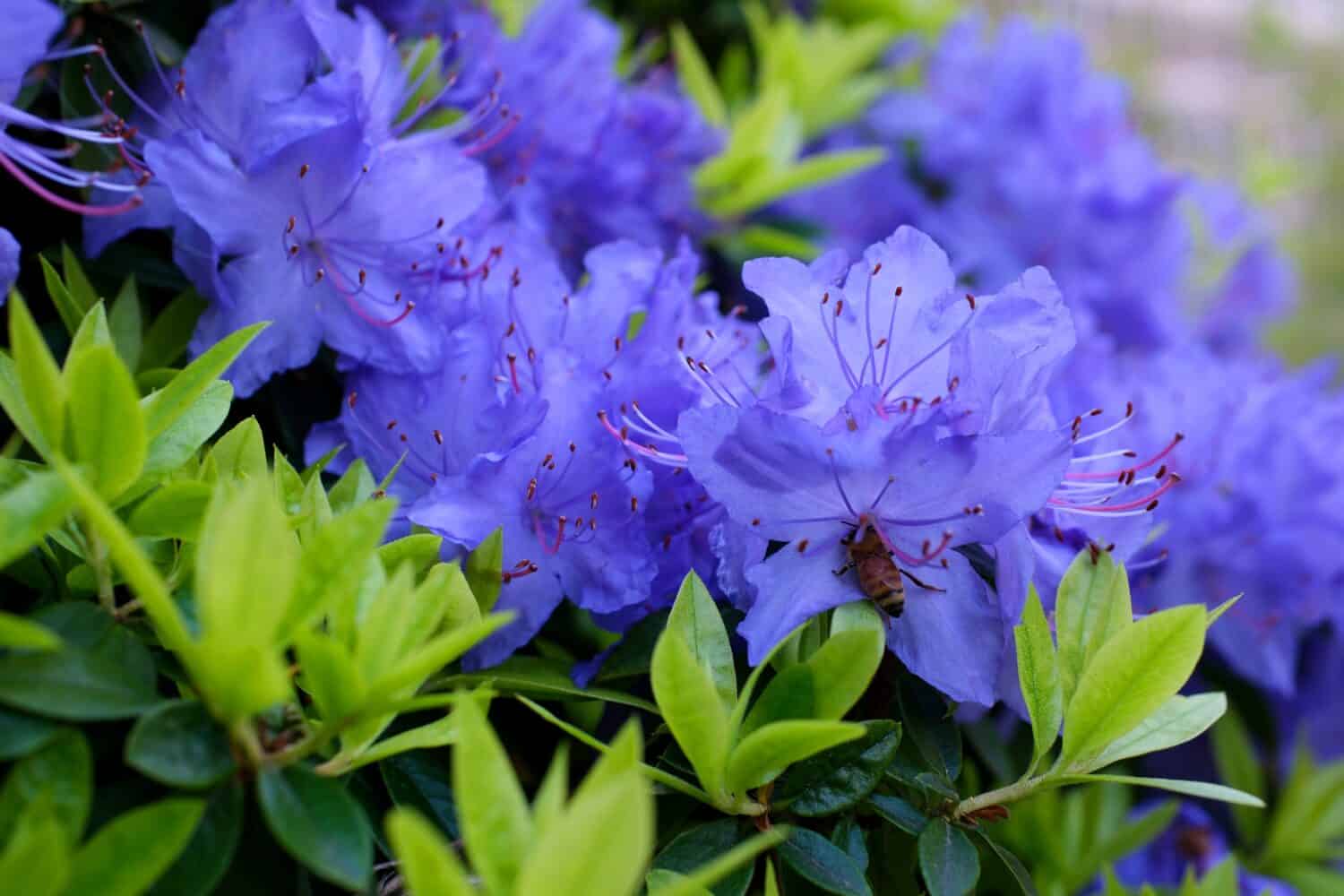
Blue rhododendrons grow in USDA zones 3 and up.
©Oleksandra Kharkova/Shutterstock.com
11. Blue Crape Myrtle
Blue crape myrtle is a sun-loving tree from Australia and southeast Asia. Many varieties exist, but some of the best have beautiful blue flowers in summer and early fall, such as the cultivar True Blue. Crape myrtle’s eight-inch long panicles of frilly blue flowers create a vivid splash of blue when other plants fade for winter.
Crape myrtle reaches 20 feet tall (although dwarf versions top out at five feet) and really needs a sunny spot to flower well. If you have a hot spot in well-drained, fertile soil that’s sheltered from the wind, that’s perfect.
In late fall, crape myrtle’s foliage turns red, gold, and orange before falling to reveal papery bark that peels off to reveal a smooth underside. Don’t make the mistake of hard pruning. Crape myrtles flower on old and new wood. Removing all its foliage (as was suggested by horticulturists in the past) just weakens it.
Despite its sun requirements, crape myrtle is hardy down to USDA growing zone 3! It gets stronger with age, so protection against snow and frost is only required for young plants.
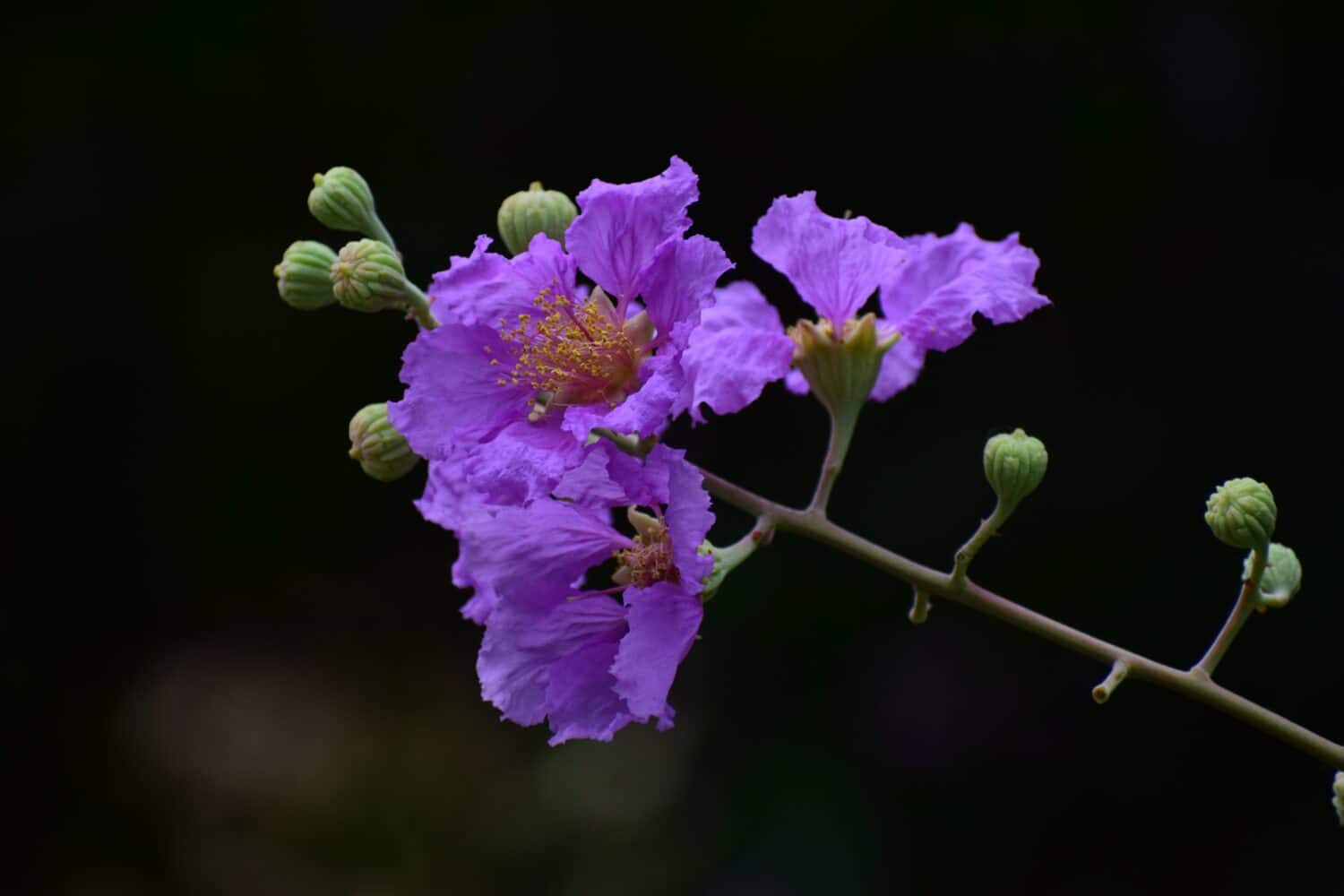
Blue crape myrtle needs lots of sun, but it’s hardy down to USDA zone 3.
©Manas Mistry/Shutterstock.com
The photo featured at the top of this post is © Harry Thomas Flower/Shutterstock.com
Thank you for reading! Have some feedback for us? Contact the AZ Animals editorial team.




